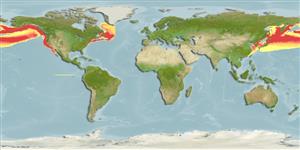>
Aulopiformes (Grinners) >
Anotopteridae (Daggertooth)
Etymology: Anotopterus: Greek, a = without + Greek, noton = back + Greek, pteron = fin (Ref. 45335); nikparini: Named for Nikolai V. Parin.
Eponymy: Professor Dr Nikolai Vasilyevich Parin (1932–2012). (see Parin, also see Nik) (Ref. 128868), visit book page.
Environment: milieu / climate zone / distribuzione batimetrica / distribution range
Ecologia
marino batipelagico; distribuzione batimetrica 0 - 2750 m (Ref. 31260), usually 0 - 700 m (Ref. 31260). Temperate
North Pacific: Bering Sea and Gulf of Alaska; south in Pacific waters to about 25°N, south of Baja California and Japan.
Size / Peso / Age
Maturità: Lm ? range ? - ? cm
Max length : 146 cm TL maschio/sesso non determinato; (Ref. 6885); peso massimo pubblicato: 1.7 kg (Ref. 6885)
Short description
Chiavi di identificazione | Morfologia | Morfometria
Spine dorsali (totale) : 0; Raggi dorsali molli (totale) : 0; Spine anali: 0; Raggi anali molli: 14 - 17; Vertebre: 78 - 80. Dark brownish, silvery ventrally; paired fins and caudal fin uniformly black. Body extremely elongate. Large adults with a pair of dermal keels midlaterally on each side. Small, flexible projection at tip of lower jaw. Gill membranes joined forward, below anterior edge of eye, and free from isthmus. No rayed dorsal fin. No scales (Ref. 43939). In adults, head depth 29-33% of lower jaw length. Postorbital area 8.1-9.7% SL or 34.4-38.8% (less than 3 times smaller than HL). Rear edge of gill cover overlaps with the vertical of the 5th vertebrae. Postadipose distance 7-8% SL (Ref. 31260).
Body shape (shape guide): eel-like; Cross section: compressed.
Found in a wide range of depths, sometimes near surface (Ref. 2850) to below 2,000 m. Larger adults inhabit colder water toward the poles, whereas, the young and smaller adults inhabit more temperate regions (Ref. 35956). Feed on mollusks, crustaceans, marine worms, coelenterates, salps, and fishes (Ref. 4525, 6885). Its distensible body wall and large stomach can accommodate prey up to half of its own length. Oviparous, with planktonic larvae (Ref. 35956). Preyed upon by albacore, Pacific lancetfish, halibut, steelhead salmon, blue shark, pomfret, and whales (Ref. 6885).
Life cycle and mating behavior
Maturità | Riproduzione | Deposizione | Uova | Fecundity | Larve
Kukuev, E.I., 1998. Systematics and distribution in the world ocean of daggertooth fishes of the genus Anotopterus (Anotopteridae, Aulopiformes). J. Ichthyol. 38(9):716-729. (Ref. 31260)
IUCN Red List Status (Ref. 130435: Version 2024-2)
Threat to humans
Harmless
Human uses
Strumenti
Special reports
Download XML
Fonti Internet
Estimates based on models
Preferred temperature (Fonte Biblio.
123201): 1.4 - 15.3, mean 5.7 °C (based on 3019 cells).
Phylogenetic diversity index (Fonte Biblio.
82804): PD
50 = 0.7500 [Uniqueness, from 0.5 = low to 2.0 = high].
Bayesian length-weight: a=0.00102 (0.00046 - 0.00225), b=3.06 (2.88 - 3.24), in cm total length, based on all LWR estimates for this body shape (Ref.
93245).
Trophic level (Fonte Biblio.
69278): 4.5 ±0.5 se; based on diet studies.
Generation time: 2.2 ( na - na) years. Estimated as median ln(3)/K based on 1
growth studies.
Resilienza (Fonte Biblio.
120179): Medio, tempo minimo di raddoppiamento della popolazione 1.4 - 4.4 anni (K=0.5).
Fishing Vulnerability (Ref.
59153): Very high vulnerability (88 of 100).
🛈
